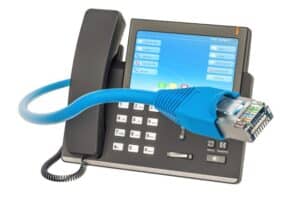VoIP is a cost-effective, scalable and flexible communication system for your business. It’s becoming quite popular around the world and especially UK. According to a 2021 report, the VoIP market of UK is expected to grow by £3.78 billion by 2026.
But how does VoIP work and what are its top features? Let’s have a look.
What is VoIP?
VoIP or Voice over Internet Protocol is a communication technology that allows you to make and receive calls using the internet. Instead of a traditional landline system where physical copper wires are used to transmit data, VoIP uses internet signals.
A basic VoIP setup consists of a router (to provide internet), a phone set (to make and receive calls) and a VoIP package. It provides users with advanced features such as auto-respondent, call centre analytics, ring groups and voicemail-to-email, making it a great substitute for businesses.
With the Big Switch Off 2025 nearing (after which the analogue telephone lines will be replaced by digital lines), it has now become even more significant to understand and implement this system.
Compare VoIP Phone System Quotes Today
How Does VoIP work?
VoIP works in 3 stages.
Stage 1: The analogue signals are converted into digital signals and sent to the VoIP network through the internet.
Step 2: These signals are converted into digital packets which are transferred to the receiver side using codecs. Codecs are software or hardware-based processes that compress and decompress the data to decrease their bandwidth so more data can be transferred in less time.
Step 3: At the receiver side, the packets are converted back into analogue signals and the person can hear your voice.
VoIP system requirements

Here is a list of all the VoIP phone system requirements you will be needing for your system. Of course, you might not require everything mentioned here because that depends on your needs.
1. Reliable internet connection:
- Router: This includes the router and/or modem. Ensure that the internet connection is stable with low latency and minimal jitter. It’s also recommended that routers support Quality of Service (QoS) to prioritise VoIP traffic.
- Bandwidth: The internet should have sufficient download and upload speeds, typically 100 Kbps/call. But if you’re using other software and integration with it, 1Mbps is recommended.
2. VoIP phones:
- IP phones: These are dedicated VoIP phone sets that look like landline phones, but are designed for internet calls. They have toggle buttons, function keys and an LCD screen that enable functions like volume control, call transfer, mute, conference calling, last number redial and voicemail, etc.
- Softphones: These are software applications that are installed on digital devices (computer, mobile and laptop) to enable them to handle VoIP calls.
3. Switches:
- Network switches: These are needed to connect multiple devices within the network for a large setup.
4. VoIP service provider:
- Subscription: This is a plan from a reputable VoIP provider that offers the necessary features and support. You can choose the one according to your needs and budget.
- SIP trunking: For larger setups, SIP trunking is needed to connect your VoIP network to the traditional phone network and support multimedia communication.
5. VoIP adapter:
- Analogue telephone adapter: These adapters convert your existing landline phones into VoIP phones.
Top features of VoIP
In comparison to landline phone systems, VoIP offers far superior features. Some of them are mentioned below.
1. Busy call forwarding: When the line is busy, this feature automatically forwards incoming calls to another pre-set number such as a colleague’s phone or voicemail. It ensures that important calls are not missed.
2. Call analytics: Call analytics provide detailed insights into call patterns, duration, frequency and duality. This data helps businesses optimise their communication strategies and improve customer service.
3. Call parking: This feature allows you to place a call on hold that can be retrieved from any other phone within the system. This is particularly useful in office environments where the call needs to be picked up by someone else or from a different location.
4. Call pulling: Call pulling lets you transfer an ongoing call from one device to another without interruption. For instance, you can start a call on your desk phone and pull it to your mobile phone as you leave the office, ensuring continuous conversation.
5. Interactive voice response (IVR): It is an automated phone system that interacts with callers through pre-recorded messages and menu options. It allows callers to navigate to the correct department or service by using their phone keypad or voice commands.
6. Conference bridge: It facilitates multi-party conferencing, enabling multiple participants to join a single call. This feature is ideal for virtual meetings or helping an agent who is not been able to resolve a customer query.
7. Push-to-talk: This feature allows users to communicate instantly with each other, similar to a walkie-talkie. By pressing a button, users can send voice messages that are instantly heard by the other person.
8. Voicemail to email: This is one of the biggest advantages of VoIP phones. This feature transcribes voicemail messages and sends them to your email as audio files or text. It allows you to access and manage voicemails conveniently from your email inbox.
9. Hot desking: Hot desking enables employees to use any available desk phone within the office by logging in with credentials. Thai feature enhances flexibility in a workspace, allowing employees to maintain their personal settings and access their call history from any phone.
10. Call blasting: Call blasting sends a pre-recorded message to hundreds of customers or leads in one go. It saves time and resources.
11. International local number: It allows businesses to have local numbers in different countries without routing the calls to their central office. This feature helps businesses to establish a local presence in multiple regions.
12. Time-based routing: Time-based routing direct calls based on the time of the day or day of the week. This ensures calls are routed to the appropriate destination, such as different departments, depending on business hours or staff availability.
Find Top VoIP Providers In The UK With ComparedBusiness
We at ComparedBusiness are experts in linking businesses with VoIP phone service providers. Just submit your business details in less than 2 minutes and we will get back to you with quotes from a list of reliable VoIP providers in the UK.
FAQs
No, VoIP does not require a traditional phone line. It uses an internet connection to make and receive calls, providing greater flexibility and often lower costs compared to traditional phone systems.
Yes, you can use your existing analogue phone with VoIP by connecting it through an Analog Telephone Adapter (ATA). The ATA converts analogue signals to digital, enabling your phone to work with a VoIP system.
Yes, you can keep your existing phone number on VoIP. Most VoIP providers offer number porting services, allowing you to transfer your current number to their system. Contact your chosen VoIP provider to initiate the porting process and retain your existing number.
